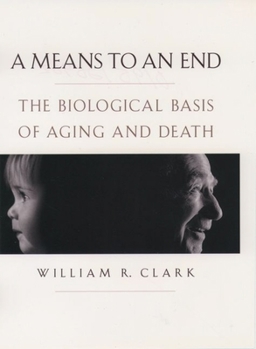A Means to an End: The Biological Basis of Aging and Death
Select Format
Select Condition 
Book Overview
Why do we age? Is aging inevitable? Will advances in medical knowledge allow us to extend the human lifespan beyond its present limits? Because growing old has long been the one irreducible reality of human existence, these intriguing questions arise more often in the context of science fiction than science fact. But recent discoveries in the fields of cell biology and molecular genetics are seriously challenging the assumption that human lifespans...
Format:Hardcover
Language:English
ISBN:0195125932
ISBN13:9780195125931
Release Date:April 1999
Publisher:Oxford University Press, USA
Length:256 Pages
Weight:1.30 lbs.
Dimensions:1.1" x 6.3" x 9.1"
Customer Reviews
5 ratings
Yes, death is genetically programmed !
Published by Thriftbooks.com User , 23 years ago
This book embraces a rational and well explained journey in the field of aging. Here I read for the first time strong statements about the programmed nature death, that is present since fertilization. We learn the basic experiments that support Haldane theory about sex and aging and we appreaciate the beatiful connection between replicative senescence and species-specifc mortality. The book is clear and well readible and I strongly recommend it to science and non-science crowd.
A clear explanation of what is currently known about aging
Published by Thriftbooks.com User , 23 years ago
Professor Clark has written a book that is detailed and accurate, and at the same time accessible to people untrained in molecular biology. If you are interested in increasing both the quality and the length of your life, read this book.
The case for programmed senescence
Published by Thriftbooks.com User , 23 years ago
Professor Clark writes with elegance and employs a reasoned tone, but he is not always direct, and often expresses ideas in the understandably tentative way of a very exacting scientist. Consequently it is not easy to see that nowhere in this book does he directly say what causes aging and death. Nor does he simply say we don't know. What he does say is there are some persuasive theories, especially the evolutionary model began by Haldane and Medawar and refined by George Williams (pp. 49-50), that are consistent with the data that "may be essentially correct, at least in broad outline." (p. 52). Clark makes it clear that we have senescence effector genes in our cells but he doesn't say how they got there, only that they were "already in place in the earliest eukaryotic organisms such as paramecia and yeast." (p. 57) The reader is left to believe that there is a mechanism that retains them, but what that mechanism might be is unclear.I am led to believe that senescence is built into our cells and is part of our genetic makeup. We are programmed to grow old and die. Just how is what Professor Clark is exploring here. He concentrates on the cellular level because it is his belief that this is where the mechanisms for senescence can be found. On page 190 he argues that senescence is genetically controlled and not the result of a random breakdown, citing the fact that "maximum lifespan is species-specific." In short, humans live a lot longer than dogs, contrary to what might be expected if senescence were caused by cells getting old and wearing out. He points out on page 48 that "mice and humans, although composed of proteins that are extremely similar at a chemical level, have both average and maximal lifespans differing by a factor of 30 or more."Clark also covers in some detail such issues as the evolution of senescence, average and maximum lifespan; genetic diseases such as Werner's syndrome, the Hutchinson-Gilford syndrome and others; oxidative stress as a cause of cellular senescence and the use of Vitamin E and other antioxidants; the aging brain and Alzheimer's disease; cancer and the social and economic effect of humans living longer. A chapter is devoted to the phenomenon of increased lifespan through restricted caloric intake.This is an authoritative and persuasive book, well written and well presented.
Excellent review of aging research for the general public
Published by Thriftbooks.com User , 24 years ago
This is a very clearly written, basic book on aging research that is up-to-date. It covers the history of aging research, with particular emphasis on Hayflick's demonstraction of replicative senesence, and gives a fascinating speculation regarding the origin of the aging process in eukaryotic cells as a consequence of sex. Despite this, I really think this is a non-technical book, as he takes time to explain even the most basic of basics, like how nucleotides make up DNA.
excellent exposition of cellular life as well as our life
Published by Thriftbooks.com User , 25 years ago
Dr. Clark has written so beautifully on a topic which is not always clearly explained. In caring for elderly patients and looking at our own health decisions, we can truly benefit from his efforts to give us his years of molecular biology experience in a well-designed format. Thank you Dr. Clark.Ellen M. O'Donohue RN BSN Kelpgull@aol.com




